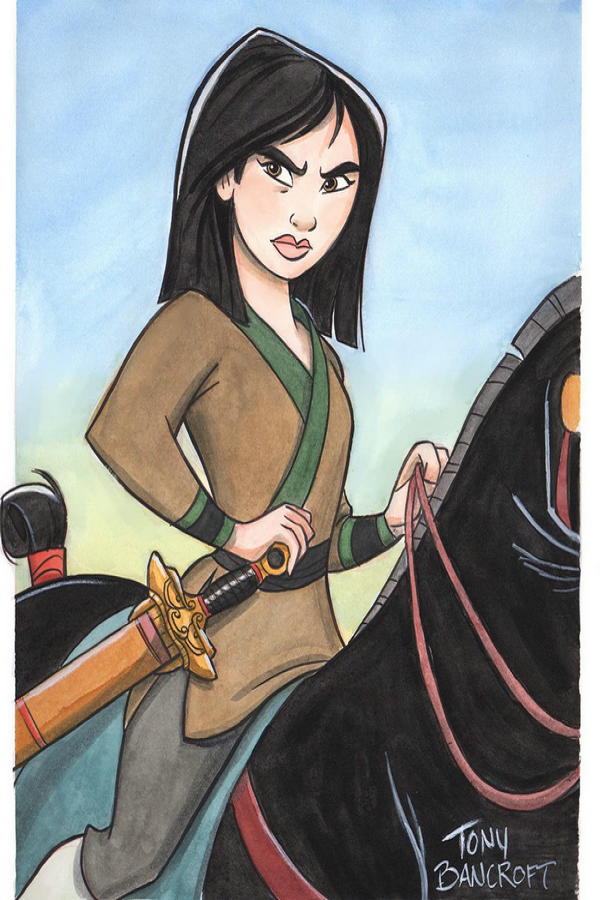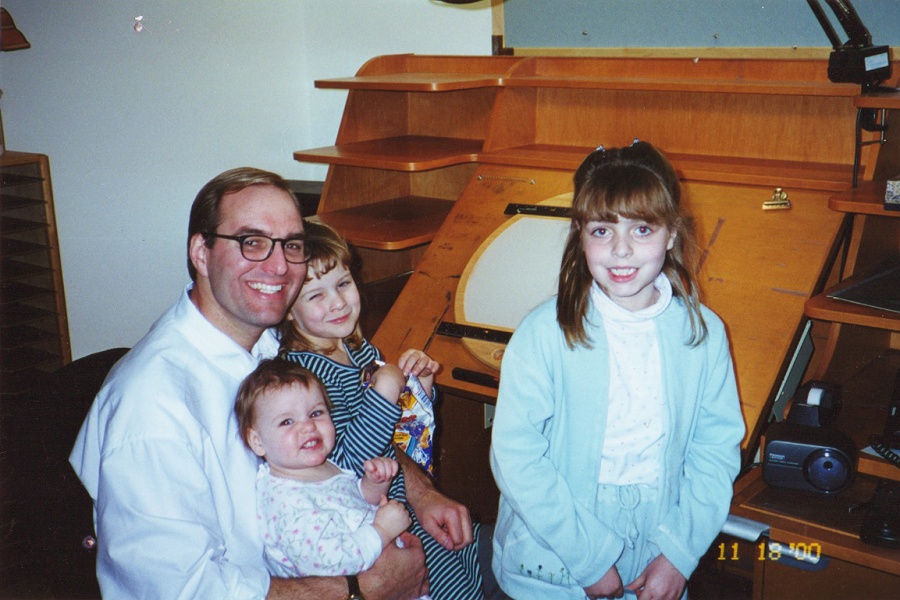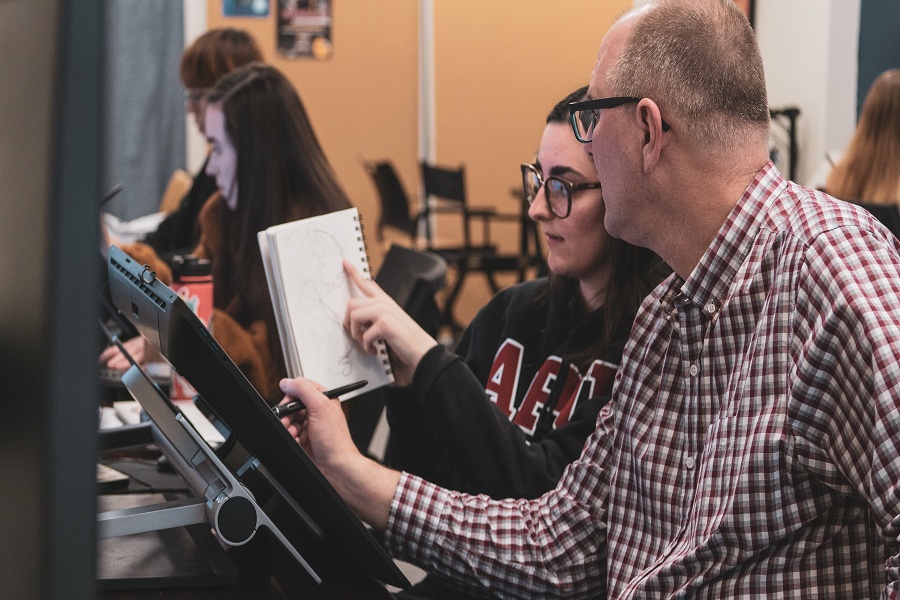Tony Bancroft: Passing on the Inspiring Female Spirit

As the 94th Academy Awards, or Oscars, scheduled for March 27 this year at the Dolby Theater in Hollywood, approached, Tony Bancroft “got pulled away for an emergency” to vote as a member of the Academy before showing up at the teleconference.
“I won’t say who I voted for,” the American 2D animator and director chuckled before emphasizing that only one female was nominated in the directing category: Jane Campion for The Power of the Dog, a Western psychological drama that was also nominated for Best Picture, Best Adapted Screenplay, and many other categories.
“More and more female animators and directors are getting opportunities, but still not enough,” he added. “It’s just changing way too slow.”
As co-director of the 1998 Disney animated feature Mulan, Bancroft has many years of experience with the creative potential of females alongside the power of identification.
An Animated Character
In a stark deviation from Disney’s damsel-in-distress princess formula characterized by classics like Sleeping Beauty and Snow White, for example, Mulan doesn’t wait around for a prince to rescue her. The fearless young woman takes matters into her own hands by disguising herself as a man to save her ailing father from serving in the imperial army and subsequently saving her emperor and nation from northern invaders, bringing honor to her family.
According to Bancroft, back in the late 1990s in the United States, a strong female character joining the Disney Princess Pantheon could have still been considered a controversy. But he saw the shift as natural after growing up with strong female figures. “I grew up in a female-dominated family,” he explained. “My twin brother and I were raised by our older sister while my mom worked full time. I’ve always believed in women as strong spirits, because that has been what they have shown me since my early childhood.”
The animated film Mulan began with a four-year journey of research, coordination, and production that were particularly intense for 27-year-old Bancroft at the time with just five years of experience as a studio animator and no directorial credits. “It was just like 100 times more difficult than being an animator,” he recalled. “As an animator, I just concentrate on one character on a very scene-by-scene basis like how I created Pumbaa in The Lion King. But when you’re a director, you have to think about the larger story, the whole arc of the movie, like who Mulan is and how the whole story should develop.”
To successfully complete the desirable shift from an actor with a pencil to a panoramic storyteller through his “first-time opportunity,” Bancroft and his team conducted extensive research on The Ballad of Mulan, the oldest known version of Mulan’s story, and set off on field excursions to China to access relevant books and art in libraries and museums to better absorb the historical environment. Ancient Chinese paintings from the era, most likely during the Northern Wei Dynasty (386-534) for example, explain why Mulan goes to see the matchmaker in a kimono with geisha makeup, according to Bancroft. But the team also chose to skip elements that would be too difficult for Chinese audiences to accept in the late 1990s. For instance, the common practice of “three-inch lotus feet” made by binding women’s feet in the feudal age is completely absent from the movie considering the custom’s “grotesque” connotations.

A portrait of the animated Mulan, who cross-dressed herself as a male warrior to save her ailing father from serving in the imperial army.
“It’s not perfect,” said Bancroft. “But we did the best we could within the limitations of access to information. We wanted Chinese people to feel that we gave them respect through the storytelling.”
Bancroft sought to bring Mulan to life via a fusion of subtle female temperament and exceptional bravery and wisdom. She comforts the captain Shang who just lost his father in the battlefield in a gentle feminine touch and places a doll with the helmet and sword of Shang’s father as a memorial. But in another scene, she attacks the enemy with an unexpected snowslide.
“She didn’t run away scared,” said Bancroft. “She didn’t give up in a fight. She solved problems by standing up to them and thinking them through and coming up with ideas that nobody else thought of. That’s how we can make it as believable as possible that a young girl could take down Chanyu, the chief of the Huns, with her mind, not her muscles.”
Mulan’s self-reflection to discover her inner self is also quite important. The song “Reflection” arrives after Mulan returns home following a failed attempt to impress her matchmaker. “You may look like a bride but you will never bring your family honor,” she scolded. The lyrics “When will my reflection look like who I am inside?” express Mulan’s desire to show the world who she really is rather than pretending to be someone she is not despite the fear of disappointing her family by doing so. Bancroft thought that would be a character who could receive empathy from viewers. “We wanted to show that she didn’t have it all worked out and did have doubts and fears,” he said. “But once there was a goal to pursue, she would make it happen.”
An Inspiring Journey
The 1998 release of Mulan was a huge success for Bancroft. The film earned over US$300 million at the global box office, and Bancroft was honored with the Annie Award for Director of the Year from ASIFA-International. Yet, the inherently inspiring power of Mulan still matters most to him. Whenever the director hit a wall in the process involving thousands of options to apply to storytelling, he would always ponder the character’s heart and love for her father to sacrifice herself to save his life. This would guide his decisions and help him endure when things got tough. “It felt like Mulan was almost like the third director,” Bancroft recalled. “She seemed to, in a fantastical way, whisper in our ears about what she would want in her story, because she became real to us.”
The story also inspired Bancroft’s three daughters, who were all heavily influenced by Mulan. “They could look up to her to achieve whatever they wanted in life,” Bancroft said. Caitlin, Bancroft’s eldest daughter, thought it was “kind of a big deal to move away from home” for college but found the courage and inspiration by recalling how Mulan left her family to bring honor back and met friends along the way.

Tony Bancroft with his three young daughters on his last day at Walt Disney Studios. After finishing Mulan, Bancroft decided to leave Disney to start his own animation company.
All his personal and intimate inspiration aside, Bancroft also thought it was a story that “needed to be told at that time” because females in the United States were not given the same freedom like males and were seeking a greater presence, voice, and power. He noted that in the film, Mulan didn’t really change herself but changed how everybody else, including the emperor, saw a woman. When Mulan is discovered to be a woman after the snowslide, the doubt in her fellow warriors doesn’t last long, and they quickly choose to support her attempt to rescue the emperor, who later honors her by offering rewards like a sword, honorable pendant, and even a job in his kingdom. “So that’s the great success,” Bancroft said. “It’s really a lesson for our society that we should encourage people to pursue their inside, regardless of gender.”
Now, Bancroft works at Azusa Pacific University, mentoring and inspiring future animators as head of the Animation and Visual Effects program commencing since 2018. He is encouraged that 13 out of the 15 students in his most recent class are female, a stark contrast to the 1990s in the United States when animation was known as “a boys’ club.” “I think the movie we made in the 1990s with a strong heroine Mulan might have paved the way,” Bancroft opined. “Girls were inspired and even considered animation an option.”
While heavy representation in education is a big step in the right direction, Bancroft remains concerned about the future of potential female leadership as directors, producers, and executives of the industry. More than 60 percent of animation and art school students are women, while only 20 percent of the creative jobs are held by women as per the U.S.-based Women in Animation (WIA) that seeks to make the gender proportion 50/50 by 2025.
“It’s the thing that really needs to change,” Bancroft emphasized. He cited Turning Red, a 2022 American animated fantasy comedy produced by Pixar and helmed by female director Domee Shi, as “a great example of where the industry should go.” Inspired by Shi’s own experiences, the film follows Mei Lee, a 13-year-old Chinese-Canadian student who, due to a hereditary curse, transforms into a giant red panda when she feels a strong emotion. “You could tell that the director really tapped into her own childhood of being anxious and picked on and wove the experiences into the story,” Bancroft said.
Bancroft seeks to regularly encourage the girls in his class so they can feel confident about their ideas and skills. He is also quite proud to help them produce animated shorts. He tends to brief all the female students on WIA, exactly in their freshman year. “I want them to know there’s an organization that can lend support to women in the animation industry, help them get jobs, and ensure their creative voices are heard.”

Tony Bancroft teaches animation at Azusa Pacific University, where the majority of his students are females. Here, a student named Sarah Eubanks confers with Bancroft to figure out a pose she struggles with in her animation film.